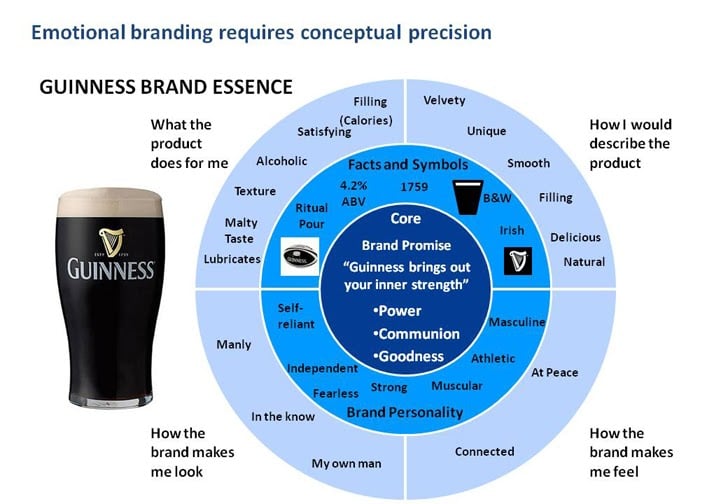
Brand essence is the core characteristic that defines a company. It is an intangible attribute that separates a brand from the competition.
A good brand essence should meet the following criteria:
- Authentic: Is it credible?
- Memorable: Is it short, punchy, and crisp?
- Unique: How does it stand out from competitors?
- Sustainable and Scalable: Will the brand essence work as the company grows?
- Relevant: Is it relevant to customers and the target audience?
This blog post will discuss what brand essence is, why it’s important, how to measure it with market research, and some real-life examples!
What is Brand Essence?
Brand essence refers to the core identity and fundamental nature of a brand.
It represents the unique qualities that define a brand and set it apart from its competitors. Brand essence goes beyond tangible aspects such as logos, slogans, or products, and delves into the emotional and intangible aspects that resonate with consumers.
Additionally, the brand essence can be thought of as a simple formula:
Brand Essence = Goals (what you want to do) + What you do + Your values (how you do what you do)
Lastly, brand essence is often expressed through a concise and powerful statement or tagline that captures the brand’s essence in a memorable way. This statement serves as a guiding principle for the brand’s communications, marketing strategies, and overall brand positioning.
What are the Elements of Brand Essence?
There’s no single trait that creates a branding essence. Instead, it encapsulates an organization’s values, personality, purpose, and overall experience it aims to deliver to its customers.
The key elements of brand essence include:
- Audience: Perhaps the most important branding element is how an organization communicates to its audience. It’s no surprise, then, that 70% of brand managers prioritize building an audience over sales. If a brand’s audience finds it hard to connect, then they’ll begin to dwindle. Do they know what your brand offers? Do they connect with your messaging?
- Brand character: A brand’s reputation is everything. What does this tell us? That consumers need brands they can trust. If consumers don’t trust your organization, this has an impact on business. To avoid this, spend time evaluating the services/products you offer. Consider their value, importance, and quality.
- Uniqueness: Consumers are drawn to brands that offer something different. Take time to study your competitors to see how you can stand out from the crowd. Conducting competitor research is the first step in seeing where your rivals are outperforming you. With this information in your pocket, you can discover new ways to brand yourself – in turn, attracting consumers.
- Enthusiasm: A successful brand needs to have energy. If a brand consistently has a lackluster, unenthused tone, consumers will notice. And once you have a good idea of who your audience is, you can adjust that tone accordingly. For example, if you attract mostly younger consumers, then you wouldn’t want a tone that caters to the older generation.
- Timeliness: Is there a need for your products/services right now? It doesn’t matter how great they are – if there’s no need for them, then consumers won’t buy them. It’s key to research who needs what product and if it’s relevant to your industry. This prevents you from finding out the hard way when sales are lacking!
- Customer loyalty: Gauging the customer satisfaction of your audience is essential in keeping them. How loyal are they? Could your competitors swoop in and take them without an issue? Make sure to understand how connected your customers are to you, and if they could be easily swayed by rival brands.
- Adjustability: Ensure your brand has an element of flexibility to it. Does your brand have room for a variety of different products or is it constricting? While it’s a good idea to have some kind of branding structure, keeping things too tight can become stale.
Why is Measuring Brand Essence Important?
Creating a strong brand essence involves understanding the target audience, identifying the brand’s unique selling proposition, and aligning it with the values and aspirations of consumers.
When a brand successfully communicates its essence, it establishes a strong emotional connection with its customers and builds brand loyalty and preference.
Here are more benefits of measuring brand essence:
Data-Driven Marketing
As brand essence forms the personality of the brand. In other words, it helps companies build a story.
This leads to better marketing strategies, and it’s easier to sell products to customers who already know what the brand is known for.
At the same time, it allows the company to build bonds with customers and meet their emotional expectations.
Recommended Reading: What is Data-Driven Decision-Making and Why It’s So Important
Greater Return on Investment (ROI)
Measuring brand essence allows companies to assess the ROI of their brand-building efforts.
By tracking changes in brand perception, loyalty, and preference over time, companies can evaluate the impact of their investments in marketing, advertising, and other brand-building activities.
This evaluation helps allocate resources more effectively and make data-driven decisions to optimize brand performance.
Improve Brand Awareness and Perception
Brand essence also allows the company to establish consistency and develop a specific reputation in the industry.
To gain traction, brands need to make sure that they clearly express their brand essence (i.e., reinforced across time, geography, and media platforms).
Furthermore, it is important that the brand essence isn’t just an “in the moment” concept, but that it can produce longevity and encompasses long-term goals that the brand wants to achieve.
Recommended Reading: How Market Research Can Improve Your Brand
How Do You Measure Brand Essence?
The most beneficial way to measure brand essence is through market research because it involves gathering data and insights from consumers to understand their perceptions, emotions, and associations with the brand.
Here are some methods commonly used in market research to measure brand essence:
- Surveys: Surveys can be conducted to gather quantitative data about consumers’ perceptions of the brand. Questions can be designed to assess how well the brand’s essence is understood and whether it aligns with consumers’ experiences. Additionally, likert scale questions, ranking exercises, and open-ended questions can be used to gauge brand attributes, emotions, and overall brand perception.
- Focus Groups: Focus groups bring together a small group of individuals to discuss their perceptions and experiences related to the brand. Through guided discussions and interactive exercises, participants can share their thoughts, emotions, and associations with the brand’s essence. This qualitative method provides rich insights and allows for probing deeper into participants’ responses.
- Brand Equity Measurement: Brand equity measurement models, such as brand association mapping, brand awareness surveys, and brand preference measurement, can provide a comprehensive assessment of the brand essence. These models evaluate the strength of associations, emotional connections, and overall brand value, helping companies understand the effectiveness of their brand essence in driving customer behavior.
- Brand Tracking Studies: Brand tracking studies involve regular monitoring of brand performance over time. Surveys or interviews are conducted at regular intervals to measure changes in brand perception, awareness, loyalty, and other relevant metrics. By tracking these indicators, companies can assess whether the brand essence is evolving, and if it aligns with consumer perceptions.
For a more in-depth overview, I recommend reading our Ultimate Guide to Brand Tracking. Or, for a quick synopsis, watch our brief video below.
Examples of Brand Essence
The use of the brand essence wheel is a marketing model created by Bates, an advertising agency in 1995.
The brand essence wheel, as shown below, helps companies create and define their brand identity.
Look at this example that analyzes Guinness’s brand essence.

Other examples of brand essence include:
- Nike = Authentic Athletic Performance
- BMW =Driving Pleasure
- Starbucks = Rewarding Everyday Moments.
- Airbnb = Belong Anywhere
As you look at the examples from these popular brands, you can think back on your memories and think of the power that brand essence holds!
Recommended Reading: Brand Like a Boss | Using Market Research to Grow Business Awareness
Final Thoughts
Brand essence is the heart and soul of a brand, representing its core identity and the emotional connection it establishes with consumers. And measuring brand essence through market research is crucial for evaluating brand performance, refining strategies, and gaining customer insights.
That’s because by understanding the power of brand essence and leveraging market research techniques, companies can cultivate strong and enduring brands that resonate with their target audience.
Real-life examples like Nike, Apple, and Coca-Cola showcase the significance of crafting and measuring brand essence to create a lasting impact in the minds and hearts of consumers.
Measure Brand Essence with Drive Research
Quantifying brand essence, while important, is often challenging to execute with little experience in market research. Drive Research, a full-service market research company can help.



